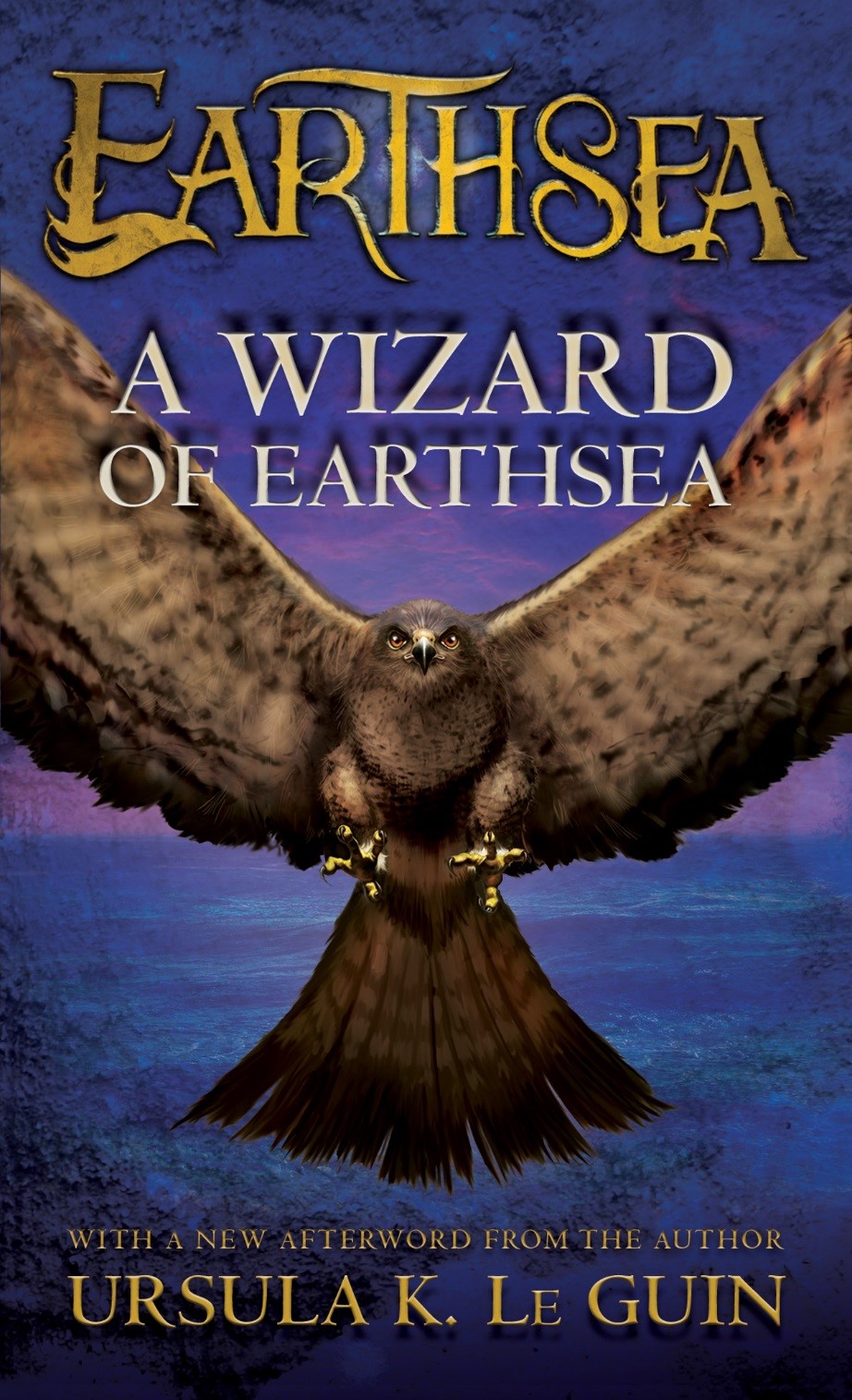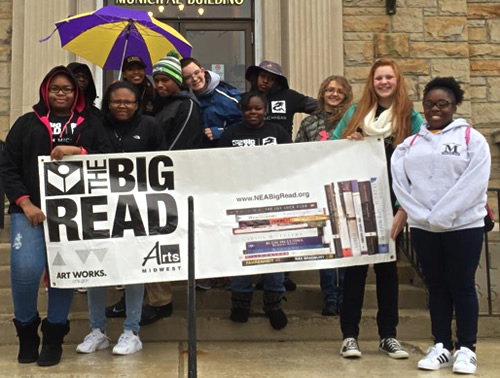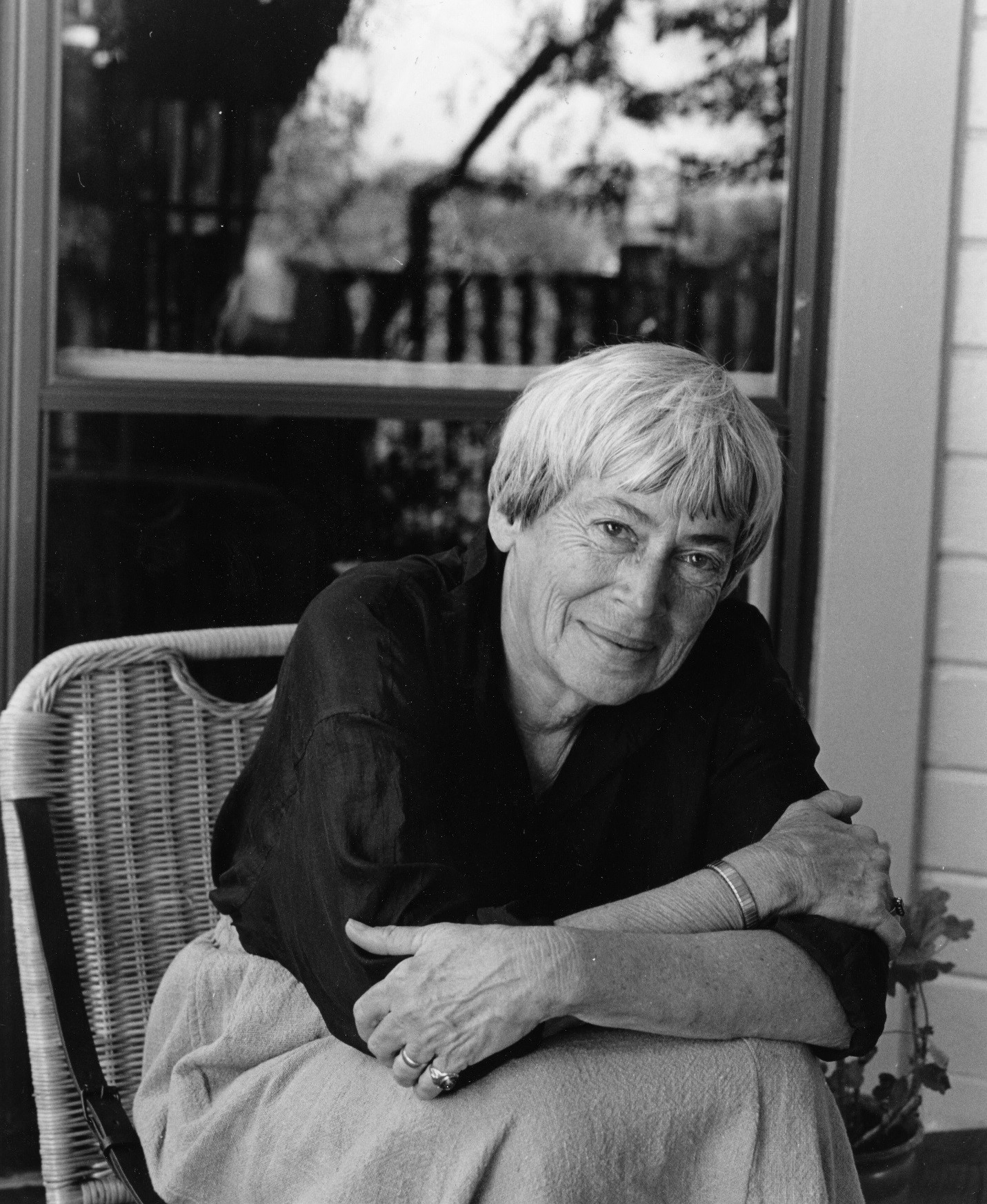A Wizard of Earthsea

Overview
This title is no longer available for programming after the 2021-2022 grant year.
A Wizard of Earthsea is “the best young adult novel of all time” with a heroic protagonist that’s “Luke Skywalker and Harry Potter and Peter Parker and Frodo Baggins all wrapped up into one,” writes Entertainment Weekly. This award-winning, introspective fantasy novel – the first of six, collectively referred to as the “Earthsea Cycle” – follows the early life of a boy from a remote village whose magical powers, intelligence, and determination get him accepted to wizard school where his pride plunges him into darkness and he must journey far to face his demon. “The most thrilling, wise and beautiful children's novel ever, it is written in prose as taut and clean as a ship's sail…. It poses the deep questions about life, death, power and responsibility that children need answering” (The Guardian). Le Guin didn’t publish her first novel until the age of 37, after which she went on to win numerous distinguished awards, including the Hugo, Nebula, Locus, and World Fantasy awards (each more than once), as well as the National Book Foundation’s Medal for Distinguished Contribution to American Letters and the Library of Congress’s Living Legend Award.
"To me a novel can be as beautiful as any symphony, as beautiful as the sea." —from her book The Wave in the Mind
Introduction
Ursula K. Le Guin's A Wizard of Earthsea (1968) is arguably the most widely admired American fantasy novel of the past fifty years. The book's elegant diction, geographical sweep, and mounting suspense are quite irresistible. Earthsea—composed of an archipelago of many islands—is a land of the imagination, like Oz, Faerie, or the dream-like realm of our unconscious. Earthsea may not be a "real" world but it is one that our souls recognize as meaningful and "true." Actions there possess an epic grandeur, a mythic resonance that we associate with romance and fairy tale.
Songs, poems, runes, spells—words matter a great deal in Earthsea, especially those in the "Old Speech" now spoken only by dragons and wizards. To work a spell one must know an object or person's "true name," which is nothing less than that object or person's fundamental essence. In Earthsea, to know a person's true name is to gain power over him or her. "A mage," we are told, "can control only what is near him, what he can name exactly and wholly."
Understanding the nature of things, not possessing power over them, is the ultimate goal of magic. Indeed, the greatest wizards do all they can to avoid using their skill. They recognize that the cosmos relies on equilibrium, appropriateness, and "balance"—the very name Earthsea suggests such balance—and that every action bears consequences. To perform magic, then, is to take on a heavy responsibility: One literally disturbs the balance of the universe.
The young Ged is born—a fated seventh son—on the island of Gont and, by accident, discovers that he possesses an innate talent for magic. Even as an untrained boy he is able to use his nascent powers to save his town from marauders. Soon, though, he goes to study with gentle Ogion the Silent, whom he foolishly fails to appreciate. Sent to complete his studies at the Archmage's school for wizards on the island of Roke, Ged grows increasingly proud, over-confident, and competitive. To display his much-vaunted skills, he rashly attempts a dangerous spell—with dire consequences for Earthsea and himself. Hoping to repair the damage he has caused, the chastened Ged embarks on a series of journeys around Earthsea—and eventually beyond the known world.
"The island of Gont, a single mountain that lifts its peak a mile above the storm-racked Northeast Sea, is a land famous for wizards." —Ursula K. Le Guin, from A Wizard of Earthsea
Major Characters in the Book
Ged
The hero of A Wizard of Earthsea is called Duny by his family and known to the world as Sparrowhawk. But Ged is his hidden true name, disclosed to him in an adolescent rite of passage. He must learn self-discipline, humility, and the power of silence. By so doing, he gradually acquires the inner balance and wisdom that will make him, in due course, worthy of two other names: Archmage and dragonlord.
Ogion the Silent
This quiet, philosophical magician is Ged's first teacher. He lives on the island of Gont in utter simplicity, yet his powers are formidable. Ogion urges moderation and restraint to the impetuous Ged—to no avail. His manner recalls that of a Taoist master, practicing stillness and non–interference (wu–wei).
Jasper and Vetch
At Roke, where Ged has gone to learn magic, he makes an enemy of the quicksilver Jasper and a friend of the stolid Vetch. These two boys pull Ged in different directions: Jasper taunts him to demonstrate just how good a magician he really is; Vetch, hoping to temper the rivalry, repeatedly urges restraint and caution. Jasper eventually leads Ged into overestimating his powers, with terrible consequences.
Serret and Yarrow
These are the two principal female figures in the novel, one reminding Ged of the dark allure of great power, the other of the satisfactions of an ordinary life. Serret is the seductive chatelaine of a strange castle, who nurses a ravaged Ged back to health—but for purposes of her own. By contrast, Vetch's sister, the kind-hearted Yarrow, offers the even greater temptation of a family, home, and children.
The Shadow
When Ged works a summoning spell over which he doesn't have full control, he releases a dark formless power of "unlife" into the world. It apparently seeks to take over his body and wreak evil through him. Much of the second half of A Wizard of Earthsea focuses on the contest between the young magician and this creature of darkness. But what, really, is the Shadow?
Sources of Inspiration
The Language of Fantasy
A writer, like a wizard, creates with words. Throughout A Wizard of Earthsea Le Guin's language is plain, strong, and exact; her tone grave and slightly formal; and the rhythm of her sentences carefully balanced and musical. Note the occasional touches of alliteration and assonance—reminiscent of Old English verse—in such phrases as this: "Forest rises ridge behind ridge to the stone and snow of the heights."
Taoism
This ancient Chinese philosophy pervades Le Guin's work. Lao Tzu's poetic meditation on how to live, the Tao-Te-Ching—roughly "The Classic Book of Integrity and the Way"—emphasizes silence, peace, and non-violence. It rejects dualism—good vs. evil, light vs. dark—for mutual interdependence, typically represented by the yin–yang symbol, made up of interlocking light and dark
semi-circles.
The Journey into the Self
Le Guin's work draws on several ideas and symbols used in cultural anthropology (see, especially, Arnold van Gennep's 1909 classic, The Rites of Passage). Some of these elements include rites of initiation, night–sea voyages, rituals of death and rebirth, and what the psychologist Carl Gustav Jung called archetypal images: the wise old man, the helpful animal, the Shadow.
Dragons
Dragons are ambiguous creatures in Earthsea. They are fearsome and destructive yet they possess great wisdom. While most literary dragons are creatures of darkness—William Blake's horrific red dragon, the covetous Smaug of Tolkien's The Hobbit, the devil serpent defeated by St. George—Le Guin's dragons are great forces of nature, dangerous and sublime.
"But you must not change one thing, one pebble, one grain of sand, until you know what good and evil will follow on that act. The world is in balance, in Equilibrium. A wizard's power of Changing and of Summoning can shake the balance of the world.... To light a candle is to cast a shadow."
—Ogion the Silent to Ged in A Wizard of Earthsea
- What are some characteristics of a young-adult novel?
- Why is this world called Earthsea? Why might Le Guin have decided to set her story in such a world?
- On the first page of the novel, we learn that Ged will eventually become Archmage and dragonlord. Doesn't this undercut a certain amount of suspense? Why would Le Guin tell us this?
- The language of A Wizard of Earthsea is often quietly poetic. Comment on three sentences that you find particularly beautiful or moving. In what ways is a writer or artist like a wizard?
- The young Ged tends to be impulsive, getting into trouble like the sorcerer's apprentice. Point out occasions in the book when Ged loses control of himself or his magic.
- Why do Ged and Jasper quarrel? Who is to blame? Why do Ged and Vetch become friends?
- There are several mentions of shadows even before Ged's attempt to raise the dead Princess Elfarran. List them. What do these various shadows suggest about Ged?
- Discuss the meaning of Ged's two encounters with the Doorkeeper of Roke.
- Compare the evil of the Shadow with the evil of the Stone of Terrenon. Are they evil in the same way? How do they differ?
- What does Ged learn from his encounter with the dragon Yevaud?
- Why do Ged and Vetch avoid using magic on their last voyage?
- Were you surprised by what happens when Ged confronts the Shadow? Would you say that his realization is true of all human experience?
The Magic of A Wizard of Earthsea Overcomes Many Challenges in Albion, Michigan

|
“Celebrating the ‘magic’ of Albion, our Big Read Kick-Off event got the month off to a good start with a parade, live music, circus performers, and tables with information and activities provided by upwards of twenty different local organizations…It was in the upper forties and pouring rain from the start of the event to its soggy end. But that did not stop the Albion College Marching Band, the Housing Commission Drum Line and Dancers, the College equestrian and basketball teams, the local chapter NAACP, local officials, and the Big Read Student Leaders from marching from City Hall to Holland Park, the site of our celebration and the former site of the segregated school in Albion. I will confess the cold and rain all but had me in despair in the early hours of that morning. But by the time the parade arrived and hundreds of people stood together, wet and laughing, in a place that once signified the division of our community, love for my town and gratitude for the NEA nearly overwhelmed me.”

|
The book “taught us how to talk to and trust one another so that we could ultimately approach issues that were difficult and immediate. It enabled us to have one of the most honest and sophisticated conversations I have been a part of about the challenges that white and black Albion students face when they go from the predominantly black Albion Community School to the predominately white Marshall High School. Ged’s struggles at the Roke School for Wizards enabled us to think critically about his social struggles and where they came from, about actual and perceived slights, about the way alienation fuels despair and [how] kindness can alleviate it. The conversation was deeply moving and could not have happened without the Big Read—not just because it was the occasion that brought us together but because in sharing a book we were able to find trust and a common language that made such a conversation about the complicated issues of difference and identity possible."
– from a report by Albion College, an NEA Big Read grant recipient in FY 2015-16.
A Wizard of Earthsea Transforms a Small Community into a Fantasy World in Dekalb, Illinois
“A Wizard of Earthsea set the tone for the entire month’s programming and invited our community members to step into a world of fantasy. Over 160 parents and children attended our kick-off Fantasy Fest, where they: played games; learned about cross-cultural perceptions of dragons; participated in fantasy literature trivia contests; engaged in crafts that reflected the characters, events, and themes of A Wizard of Earthsea; learned about ‘alchemy’ and performed chemistry experiments with the help and oversight of Northern Illinois University’s STEM Outreach; listened to a bard serenade them; learned about medieval warfare from a local SCA (Society for Creative Anachronism) branch; and interacted with fantasy characters.
“Our other showcase programs included a lecture/discussion on the importance of fantasy literature by fantasy author Howard Andrew Jones at the Ellwood House and a panel about fantasy literature, moderated by our staff expert, Steve Roman, and featuring NIU professor David Gorman, Hugo Award winning editor Lynne Thomas, and local author and University of Chicago assistant professor Mary Anne Mohanraj. These programs served to broaden the book’s audience to adults and educated attendees on the significant literary contributions of fantasy writers.
“Our magicians proved popular with patrons overall. Our Wizarding Acadamy drew [several attendees] over three weeks. NIU STEM Outreach performed a second “alchemy” demonstration, a local fortune teller gave lessons on divination, palmistry, and reading tarot cards, and a local magician gave lessons to youth on sleight-of-hand magic. Another larger program that we added was a blacksmithing demonstration given by our partner organization Glidden Homestead.”
– from a report by the Dekalb Public Library, an NEA Big Read grant recipient in FY 2014-15.
A Walk Through the Woods Brings A Wizard of Earthsea to Life in Attleboro, Massachusetts
 Geocaching participants. Photo by Amy Rhilinger, courtesy of Attleboro Public Library.
Geocaching participants. Photo by Amy Rhilinger, courtesy of Attleboro Public Library.“Our Sunset Fairy Walk and ‘Heroes Quest’ Geocaching had families and individuals walking through the woods, enjoying local nature trails while learning the folklore of the trees and joining the search for treasures that were part of [the main character’s] quest. Geocaching was so highly received that the Library and Attleboro Land trust are planning to conduct Spring Geocaching Storywalk in 2016. Meanwhile, the Oak Knoll Audubon let us know that they had the highest ever turnout for a night time walk during the Big Read.”
– from a report by the Attleboro Public Library, an NEA Big Read grant recipient in FY 2015-16.


